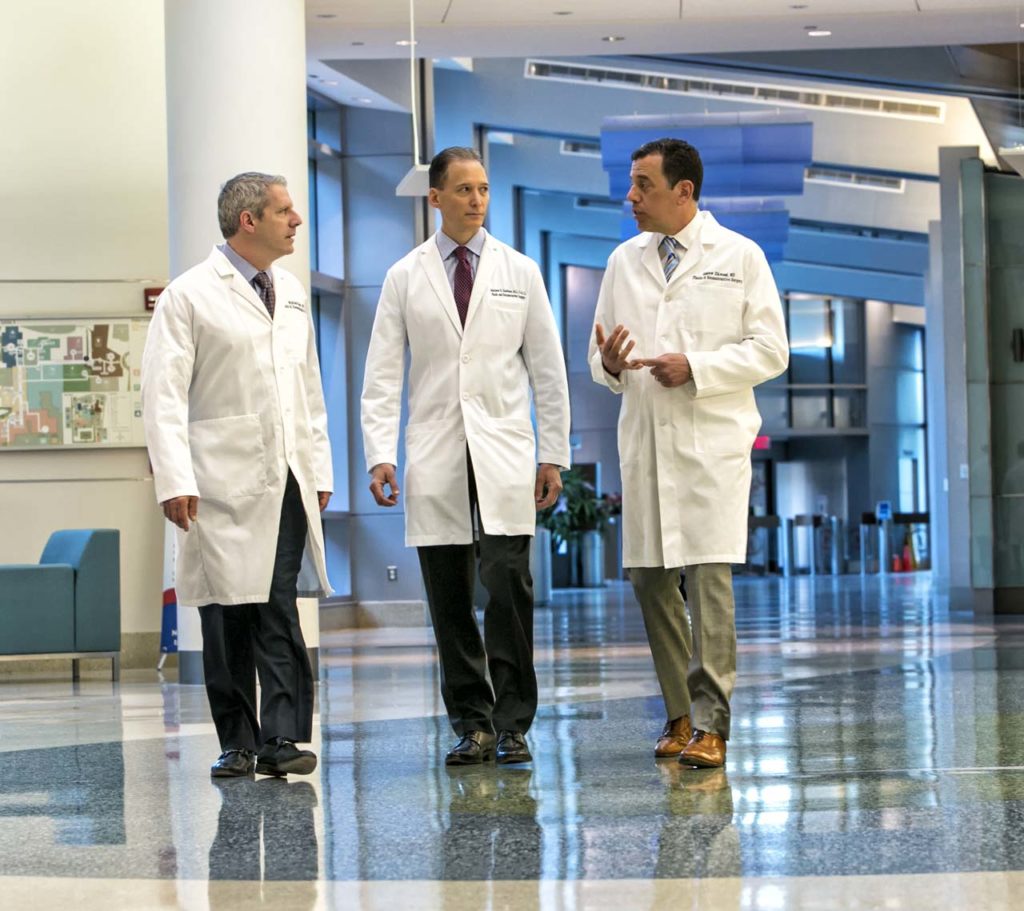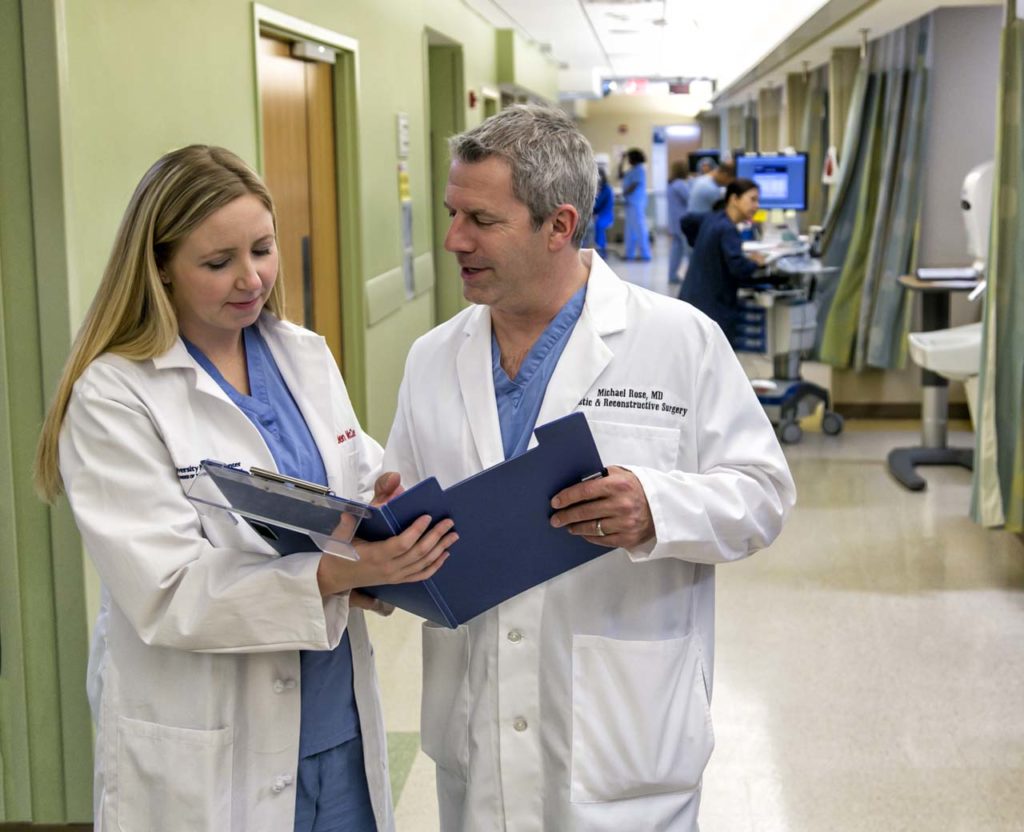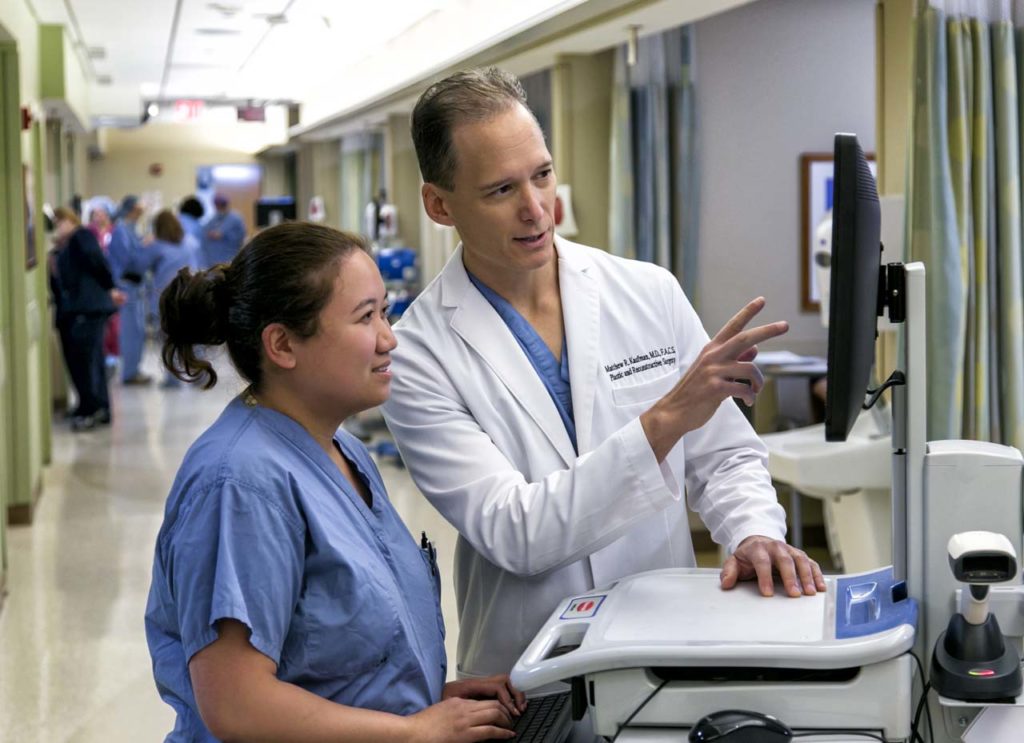BREAKTHROUGHS IN TREATMENT OF NERVE DAMAGE AND PARALYSIS AT JERSEY SHORE UNIVERSITY MEDICAL CENTER
BY JESSICA JONES GORMAN • PHOTOS BY AMESSÉ PHOTOGRAPHY
Some of the world’s most advanced surgical treatments for paralysis and nerve injuries are actually available right here in the Garden State, at the Center for Treatment of Paralysis & Reconstructive Nerve Surgery at Jersey Shore University Medical Center. The center, which provides surgical solutions for conditions such as brachial plexus injuries, peripheral neuropathy, phrenic nerve injuries, and pudendal neuralgia, has served both domestic and international patients for more than a decade. “This program is unique in that we are able to treat these forms of paralysis and nerve injury using a range of different modalities, all under one roof,” noted Dr. Andrew Elkwood, a plastic surgeon who is also the founder and director of the center. “Together, we are able to offer life altering procedures some of which cannot be found elsewhere and that integration, that progressive way of thinking as a team allows us to apply new techniques and solve the problems of a growing group of patients.”

With the shared goal of restoring function for those suffering from nerve damage and paralysis, its physicians have more than 50 years of combined experience in the field of nerve reconstruction surgery. According to Elkwood, all are highly skilled in their specialties, and work synergistically.
“Plastic surgery has two components: cosmetic and reconstructive,” he explained. “Cosmetic takes something normal and improves upon it a breast, a nose, etc. while reconstructive takes something abnormal and makes it close to normal a hair lip, mastectomy, or scars from trauma. And then there’s a subsection of reconstructive plastic surgery that restores function. Micro surgeons can take an arm that is torn off and put it back on, fixing the nerves in the process. There’s a small population of us in the country plastic surgeons and micro surgeons who work on the nerves a sort of overlap between neurosurgery and plastic surgery. And it was because of that overlap that we created this center.”
The teams specialize in lower extremity nerve reconstruction, including nerve decompression surgery for the treatment of neuropathy; upper extremity nerve reconstruction, including brachial plexus reconstruction; and swallowing disorders after stroke, diaphragm paralysis, and complications following spinal cord injuries. It also provides advanced treatments for foot drop; nerve compression syndromes; occipital neuralgia; paralysis resulting from accidents, trauma and/or strokes; paralyzed diaphragm/ventilator based breathing; phrenic nerve injuries; and spinal cord injuries.

The center’s treatment of pudendal neuralgia is particularly ground breaking. “The pudendal and sciatic nerves are the main nerves that come out of the back and extend to the pelvis,” Elkwood noted. “After childbirth, or a failed back surgery, this nerve can become entrapped, and often causes pain, numbness, or urinary or bowl dysfunction. The symptoms, which mimic sciatic pain or present as pelvic pain, are often regarded as psychological. But it is indeed a real physiological problem that can be treated surgically or, in milder cases, with non surgical therapies. It’s a surgery I love to do because it often offers immediate relief to people who have been told they would just have to live with this debilitating chronic pain.”
Elkwood also treats brachial plexus injuries. “A very specialized surgery can fix these injuries of the arm and chest that are often the result of accidents or breast cancer treatments, which can cause paralysis, numbness, or pain of the arm,” he explained. Dr. Matthew Kaufman, a reconstructive plastic surgeon and otolaryngology expert, treats phrenic nerve injuries and has pioneered world class treatments to reverse diaphragm paralysis. he phrenic nerve controls the function of the diaphragm muscle, the primary muscle involved in breathing,” he said. “We treat paralysis of that muscle, nerve damage that comes from trauma or chronic degeneration in the neck or spine.”
Kaufman, who helped pioneer the treatment about 12 years ago, compares the procedure to coronary bypass.
“We first identify the site of injury, whether in the neck or chest cavity, and consider the cause,” he noted. “If the injury is due to scar formation, we clean up the scar with decompression. But if the nerve is cut or damaged in some other way, we can do a transplant, taking a nerve out of the leg and bypassing the damaged segment. It’s a similar technique to heart bypass,” adding that the work is extremely fulfilling because “we restore function to people who have run out of options. Providing a vibrant life and normal breathing to patients who have lost that basic necessity is honestly the most rewarding part of my job. But it could not be possible without our highly skilled team of experts physicians…therapists who work together to identify and fix the problem. Over the past several years, we’ve successfully completed about 450 of these procedures. In the future, I am confident, that number will only grow.”

Dr. Michael Rose, who serves as the chief of Jersey Shore University Medical Center’s division of plastic surgery, specializes in the treatment of all forms of neuropathy.
“My focus is on some interesting nerve procedures that treat lower extremity neuropathy,” he said.” The weakness, numbness, and pain associated with this condition is often thought of as bad luck, a severe side effect of diabetes, and many patients I see are often told that there is nothing that can be done to relieve it. But there are efficient ways to surgically release the nerves in a special way that will give significant relief of symptoms.
Peripheral neuropathy, which can also be caused by injury, chemotherapy, alcoholism, and vitamin deficiency, is treated by loosening the sheath in which the nerve lives. “Neuropathy is a sick nerve; the way a human being feels swollen and sti during sickness is the same way a nerve reacts during sickness,” Rose said. “During treatment, we go in and loosen the nerve’s sheath, giving it breathing room. It’s not a cure for diabetes, but it helps manage the pain associated with it. “Twenty years ago, this was experimental; there was no surgical option for people with this disorder,” he continued. “Now the procedure has become mainstream, with major benefits and minimal risk. That’s why I’m proud to be associated with other doctors who share the same vision, doing things that are outside the box, but also truly effective.”

According to Elkwood, the center’s specialty surgeries have attracted patients from around the world, providing hope and treatment for many who have suffered for years. “Our program is well equipped to deal with patients from around the country and the world, because we have a very large population of people from outside the local area,” he said. “Our nurse navigator handles all of the internet inquiries and starts the process with a Skype call, which brings us a good preliminary understanding of the case. We also have a concierge program to expedite travel. If we can see them, diagnose them, and treat them all in one visit, we will, but sometimes a few trips are required, so our staff takes all of the necessary steps to expedite treatment from a distance.”
Elkwood is proud and humbled by the center’s success.
“It’s extremely full filling to look back and see how much we’ve accomplished for patients,” he said. “But by the same token, we are still a work in progress. In the future, we plan to push the boundaries and bring even more innovation to the table. Improving lives will always be our goal.”
Hackensack Meridian Health
800.560.9990 / meridianhealth.com


